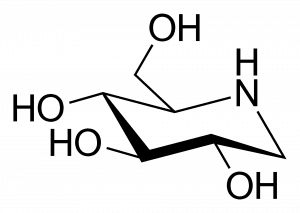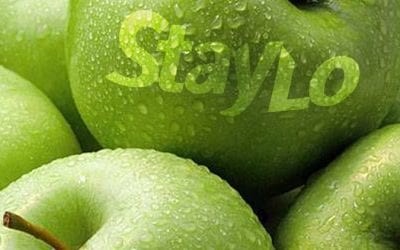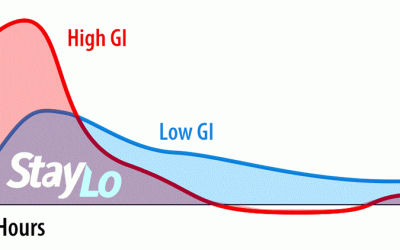WHAT IS 1-DEOXYNOJIRIMYCIN
Also known as DNJ what is the active ingredient of StayLo?
DNJ
What is it in simple language
DNJ is a naturally occurring and potent sugar look alike that blocks one the enzyme your body puts out to break down starch and table sugar. It is most often found in mulberry leaves and silkworms at small doeses. DNJ possesses anti-hyperglycemic, anti-obese, anti-viral and anti-tumor properties.
StayLo uses DNJ as the main active ingredient by using a patented water based extraction process and delivers a dose that is 5% DNJ to block up to 40% or more of the carbs and table sugar that makes up much of the food we eat.
DNJ
What is it in scientific terms
 1-Deoxynojirimycin (DNJ or 1-DNJ), also called duvoglustat or moranolin, is an alpha-glucosidase inhibitor, that works by preventing the digestion of carbohydrates (such as starch and table sugar). Carbohydrates are normally converted into simple sugars (monosaccharides) by alpha-glucosidase enzymes present on cells lining the intestine, enabling monosaccharides to be absorbed through the intestine. Hence, alpha-glucosidase inhibitors reduce the impact of dietary carbohydrates on blood sugar. According to the NIH DNJ is a potent α-glucosidase inhibitor and it possesses anti-hyperglycemic, anti-obese, anti-viral and anti-tumor properties. Some derivatives of 1-DNJ, like miglitol, miglustat and migalastat, were applied clinically to treat diseases such as diabetes and lysosomal storage disorders.
1-Deoxynojirimycin (DNJ or 1-DNJ), also called duvoglustat or moranolin, is an alpha-glucosidase inhibitor, that works by preventing the digestion of carbohydrates (such as starch and table sugar). Carbohydrates are normally converted into simple sugars (monosaccharides) by alpha-glucosidase enzymes present on cells lining the intestine, enabling monosaccharides to be absorbed through the intestine. Hence, alpha-glucosidase inhibitors reduce the impact of dietary carbohydrates on blood sugar. According to the NIH DNJ is a potent α-glucosidase inhibitor and it possesses anti-hyperglycemic, anti-obese, anti-viral and anti-tumor properties. Some derivatives of 1-DNJ, like miglitol, miglustat and migalastat, were applied clinically to treat diseases such as diabetes and lysosomal storage disorders.
DNJ is most commonly found in mulberry leaves. Although it can be obtained in small quantities by brewing an herbal tea from mulberry leaves. StayLo’s extraction process is a patented water extraction that obtains large quantities (5%) of DNJ.
1-Deoxynojirimycin is a polyhydroxylated piperidine alkaloid produced from D-Glucose in various plants, such as Commelina communis, and in the Streptomyces and Bacillus bacteria. High quantities of this azasugar are produced in Bacillus subtilis, a process initiated by a TYB gene cluster composed of gabT1 (aminotransferase), yktc1 (phosphatase), and gutB1 (oxidoreductase).
In Bacillus subtilis, D-glucose first undergoes glycolysis, opening the 6 member ring and producing fructose-6-phosphate. GabT1 catalyzes transamination at the C2 position, followed by a dephosphorylation by the Yktc1 enzyme, resulting in 2-amino-2-deoxy-D-mannitol (ADM), an essential precursor. Regio-selective oxidation by GutB1 occurs at the exposed C6 hydroxyl of ADM, pushing a C2-N-C6 cyclization of the resulting 6-oxo intermediate, creating Manojirimycin (MJ). Epimerization of MJ at the C2 position yields the nojirimycin isomer. Nojirimycin is then dehydrated (loss of -OH at C1 position), along with reduction of the imine moiety. This results in the product 1-DNJ.
DNJ
Scientific studies done by others
- 1-Deoxynojirimycin and its Derivatives: National Institute of Health
- Evaluation of the anti-hyperglycemic effect and safety of microorganism 1-deoxynojirimycin
- 1-Deoxynojirimycin from mulberry leaves changes gut digestion and microbiota composition in geese
- Mulberry 1-deoxynojirimycin (DNJ): an exemplary compound for therapeutics
- Effect of 1-Deoxynojirimycin Isolated from Mulberry Leaves on Glucose Metabolism and Gut Microbiota in a Streptozotocin-Induced Diabetic Mouse Model | Journal of Natural Products (acs.org)
- 1-Deoxynojirimycin, its potential for management of non-communicable metabolic diseases
- 1-Deoxynojirimycin in Mulberry (Morus indica L.) Leaves Ameliorates Stable Angina Pectoris in Patients With Coronary Heart Disease by Improving Antioxidant and Anti-inflammatory Capacities
- An overview of the biological production of 1-deoxynojirimycin: current status and future perspective
KNOWLEDGE ARTICLES
Other articles that might be of interest
Are Granny Smith apples the healthiest apples?
Are Granny Smith apples the healthiest apples? With tall tales of Johnny Appleseed, apple cider and the classic apple pie, Americans love their apples. Of course, apples are popular the world over. (Did you know apple pie was brought to the original 13 colonies by...
Glycemic Index & Glycemic Load
The Glycemic Index (GI) measures how carbohydrates & sugars affect your blood glucose levels, helping you choose foods to maximize your nutrition and health. Carbs & Proteins (which get broken down into sugars by your body) are the energy that run your brain,...

